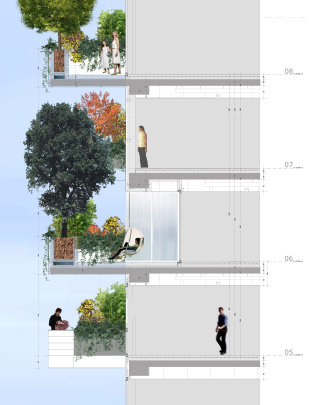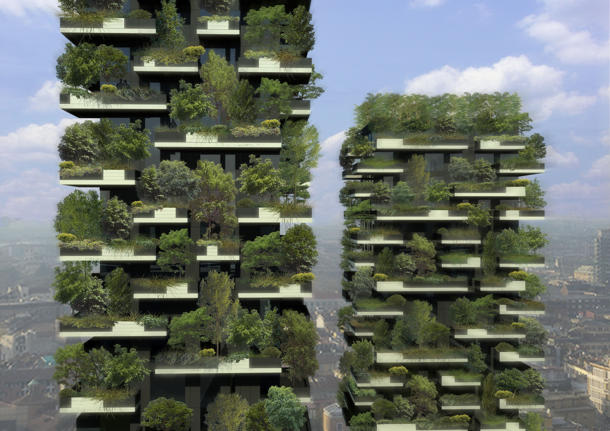This 15-apartment housing complex in Hamburg, Germany, is definitely not the first
residential building to produce every drip of energy it uses, but the
newly completed lime green box is, in fact, the very first to owe its
net-zero status to the growth of live algae. The structure, known as BIK, is armored
in panels designed to nurture algae growth, with water, nutrients, and
carbon dioxide pumping inside each of the building's 129 "bioreactors."
As the sun shines, the algae photosynthesizes and grows until there's
enough biomass for the structure's mechanics to convert the residue into
energy. The algae system, supplemented by solar panels and
ultra-insulating architecture designed to keep indoor temperatures
comfortable without using any energy at all, means the creators of BIK,
which include Spitterwerk Architects and the global consulting firm ARUP, can loudly boast the building's complete energy independence.
Read more: http://homes.yahoo.com/news/net-zero-apartments-powered-live-algae-151500406.html
Showing posts with label green sustainable. Show all posts
Showing posts with label green sustainable. Show all posts
Thursday, April 11, 2013
Wednesday, April 3, 2013
Organic rice farmer in India yields over 22 tons of crop on only two acres, proving the fraud of GMOs and Big Ag
(NaturalNews) Despite all the claims made by industry-funded hacks that
genetically-modified organisms (GMOs) and other industrial agricultural
methods are necessary for the future of humanity, it is the traditional
growing methods that continue to shine through as the real sustainers of
life. As reported by Gaia Health, Indian rice farmers using
traditional, organic growing methods are achieving yields far higher
than farmers using more modern methods.
In the case of Sumant Kumar, rice yields have surpassed the national average per hectare (about 2.5 acres) nearly ten-fold. According to reports, Kumar is currently yielding about 22.4 tons of rice per hectare, greatly surpassing that of other rice farms currently outputting roughly 2.3 tons per hectare. His secret? A traditional crop management protocol known as System of Root Intensification, or SRI.
Farmers adhering to SRI techniques will typically plant about half the number of seeds as farmers using more modern methods, and will space them out at intervals of about 10 inches. They also plant their seeds much younger, and keep the soil dryer, while paying much closer attention to weed growth. By hand-removing weeds, SRI farmers are able to allow more water and nutrients to feed their rice plants, which results in significantly higher yields.
"Farmers use less seeds, less water and less chemicals but they get more without having to invest more," says Dr. Surendra Chaurassa, agriculture minister to the region where Kumar's farm is located, as quoted by The Observer. "This is revolutionary. I did not believe it to start with, but now I think it can potentially change the way everyone farms. I would want every state to promote it. If we get 30 to 40 percent increase in yields, that is more than enough to recommend it."
In the case of Sumant Kumar, rice yields have surpassed the national average per hectare (about 2.5 acres) nearly ten-fold. According to reports, Kumar is currently yielding about 22.4 tons of rice per hectare, greatly surpassing that of other rice farms currently outputting roughly 2.3 tons per hectare. His secret? A traditional crop management protocol known as System of Root Intensification, or SRI.
Farmers adhering to SRI techniques will typically plant about half the number of seeds as farmers using more modern methods, and will space them out at intervals of about 10 inches. They also plant their seeds much younger, and keep the soil dryer, while paying much closer attention to weed growth. By hand-removing weeds, SRI farmers are able to allow more water and nutrients to feed their rice plants, which results in significantly higher yields.
"Farmers use less seeds, less water and less chemicals but they get more without having to invest more," says Dr. Surendra Chaurassa, agriculture minister to the region where Kumar's farm is located, as quoted by The Observer. "This is revolutionary. I did not believe it to start with, but now I think it can potentially change the way everyone farms. I would want every state to promote it. If we get 30 to 40 percent increase in yields, that is more than enough to recommend it."
Thursday, March 28, 2013
‘Vertical forest’ skyscrapers coming to Milan
In Milan,
a new kind of skyscraper is under construction. Once complete later
this year, the two-building project will be covered in greenery, an
effect that gives the buildings their name: Bosco Verticale, or Vertical
Forest.
 A plan for one of the apartments. (Courtesy of Boeri Studio)Yahoo!
News spoke with Boeri Studio, the architectural firm behind the
buildings' design. Construction on the residential skyscrapers began in
2008 and is set to be complete sometime this year when people can move
in. But people aren't the only residents. Also moving in: a heckuva lot
of trees, plants, and shrubs.
A plan for one of the apartments. (Courtesy of Boeri Studio)Yahoo!
News spoke with Boeri Studio, the architectural firm behind the
buildings' design. Construction on the residential skyscrapers began in
2008 and is set to be complete sometime this year when people can move
in. But people aren't the only residents. Also moving in: a heckuva lot
of trees, plants, and shrubs.
 A plan for one of the apartments. (Courtesy of Boeri Studio)Yahoo!
News spoke with Boeri Studio, the architectural firm behind the
buildings' design. Construction on the residential skyscrapers began in
2008 and is set to be complete sometime this year when people can move
in. But people aren't the only residents. Also moving in: a heckuva lot
of trees, plants, and shrubs.
A plan for one of the apartments. (Courtesy of Boeri Studio)Yahoo!
News spoke with Boeri Studio, the architectural firm behind the
buildings' design. Construction on the residential skyscrapers began in
2008 and is set to be complete sometime this year when people can move
in. But people aren't the only residents. Also moving in: a heckuva lot
of trees, plants, and shrubs.
The two buildings (26 stories and
18 stories) will be quite literally covered in green: 480 big and
medium-size trees, 250 small trees, and roughly 11,000 groundcover
plants, according to the firm. It's the equivalent of a hectare (almost
2.5 acres) of forest on the sides of the buildings, the firm says.
Subscribe to:
Posts (Atom)
